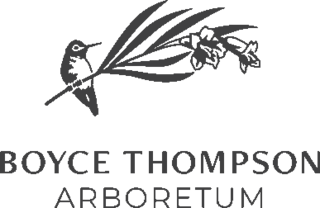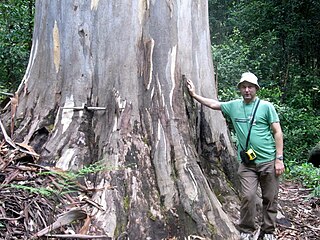
Devonport is a port city situated at the mouth of the Mersey River on the north-west coast of Tasmania, Australia. Positioned 47 kilometres (29 mi) east of Burnie and 98 kilometres (61 mi) north of Launceston, its harbour manages over half of Tasmania's imports and exports, standing as the busiest freight port on the island. Devonport also plays a central role in Tasmania's trade sector, supporting industries such as agriculture, manufacturing, and tourism. The City of Devonport's gross domestic product (GDP) was estimated at $3.5b in 2023.

Boyce Thompson Arboretum is the oldest and largest botanical garden in the state of Arizona. It is one of the oldest botanical institutions west of the Mississippi River. Founded in 1924 as a desert plant research facility and “living museum”, the arboretum is located in the Sonoran Desert on 392 acres (159 ha) along Queen Creek and beneath the towering volcanic remnant, Picketpost Mountain. Boyce Thompson Arboretum is on U.S. Highway 60, an hour's drive east from Phoenix and 3 miles (4.8 km) west of Superior, Arizona.

An arboretum is a botanical collection composed exclusively of trees and shrubs of a variety of species. Originally mostly created as a section in a larger garden or park for specimens of mostly non-local species, many modern arboreta are in botanical gardens as living collections of woody plants and are intended at least in part for scientific study.

The Tasmanian temperate rain forests are a temperate broadleaf and mixed forests ecoregion in western Tasmania. The ecoregion is part of the Australasian realm, which includes Tasmania and Australia, New Zealand, New Guinea, New Caledonia, and adjacent islands.

Eucryphia is a small genus of trees and large shrubs native to the south temperate regions of South America and coastal eastern Australia, mainly Tasmania. Sometimes placed in a family of their own, the Eucryphiaceae, they are placed by more recent classifications in the Cunoniaceae. There are seven species, two in South America and five in Australia, and several named hybrids.

The Arnold Arboretum is a botanical research institution and free public park affiliated with Harvard University and located in the Jamaica Plain and Roslindale neighborhoods of Boston.

The Holden Arboretum, in Kirtland, Ohio, is one of the largest arboreta and botanical gardens in the United States, with more than 3,600 acres (1,500 ha), including 600 acres (240 ha) devoted to collections and gardens. Diverse natural areas and ecologically sensitive habitats make up the rest of the holdings. Holden's collections includes 9,400 different kinds of woody plants, representing 79 plant families.

The Government Botanical Garden is a botanical garden in Udhagamandalam, near Coimbatore (Ooty), Tamil Nadu state, India laid out in 1848. The gardens, divided into several sections, cover an area of around 22 hectares, and lie on the lower slopes of Doddabetta peak. The garden has a terraced layout. It is maintained by the Tamil Nadu Horticulture Department.

Klehm Arboretum & Botanic Garden is a nonprofit arboretum and botanical garden located at 2715 South Main Street, Rockford, Illinois.

The Morris Arboretum & Gardens of the University of Pennsylvania is the official arboretum of the Commonwealth of Pennsylvania. The Arboretum is open daily except for major holidays. It is located at 100 East Northwestern Avenue, Chestnut Hill, Philadelphia, Pennsylvania.

Rail transport in Tasmania consists of a network of narrow gauge track of 1,067 mm reaching virtually all cities and major towns in the island state of Tasmania, Australia. Today, rail services are focused primarily on bulk freight, with no commercial passenger services being operated. The mainline railways of Tasmania are currently operated by TasRail, a Government of Tasmania-owned Corporation, who owns and maintains both rolling stock, locomotives, and track infrastructure.

The Tasmanian Museum and Art Gallery (TMAG) is a museum located in Hobart, Tasmania. The museum was established in 1846, by the Royal Society of Tasmania, the oldest Royal Society outside England. The TMAG receives 400,000 visitors annually.

Athrotaxis selaginoides is a species of Athrotaxis, endemic to Tasmania in Australia, where it grows in mountainous areas at 400–1,120 m elevation. Snow frequently falls here in the colder months, though possible all year round. It is often called King Billy pine or King William pine, although it is not a true pine.

The Currency Creek Arboretum is located in the Australian state of South Australia near the small town of Currency Creek and south of the state capital of Adelaide. CCA is a 32-hectare (79-acre) specialist Eucalypt arboretum and research centre, composed solely of Australian native plants.
Raleigh Adelbert Black was an Australian botanist and public servant best known for his large private herbarium, most of which is housed at the National Herbarium of Victoria. His collection of Tasmanian plants is considered one of the largest and most representative collections of Tasmanian flora from the first half of the twentieth century.

The biodiversity of Tasmania is of biological and paleoecological interest. A state of Australia, it is a large South Pacific archipelago of one large main island and a range of smaller islands. The terrain includes a variety of reefs, atolls, small islands, and a variety of topographical and edaphic regions on the largest island, all of which promote the development of concentrated biodiversity. During long periods geographically and genetically isolated, it is known for its unique flora and fauna. The region's climate is oceanic.

Agastachys odorata, commonly known as the white waratah or fragrant candlebush, is the sole member of the genus Agastachys in the protea family. It is an evergreen shrub to small tree and is endemic to the heaths and buttongrass sedgelands of western Tasmania.
Tasmania is home to 'Australia’s largest cool temperate rainforests. Most of Tasmania’s rainforests occur in the North-West and throughout the North East highlands. Cool temperate rainforests typically have a heavy rainfall, cool climate, favor high altitudes and have a limited availability of light.
Eugenana is a rural locality in the local government area (LGA) of Devonport in the North-west and west LGA region of Tasmania. The locality is about 9 kilometres (5.6 mi) south-west of the town of Devonport. The 2021 census recorded a population of 169 for the state suburb of Eugenana. It is a rural suburb of Devonport. Lake Eugenana, which is 123 metres above sea level, is situated here.

















